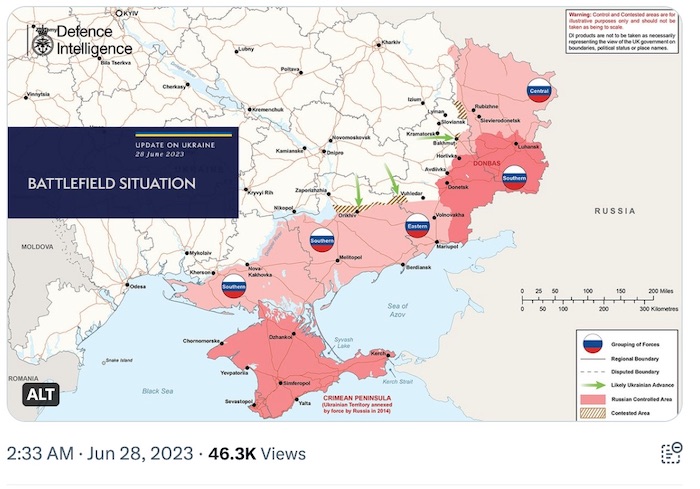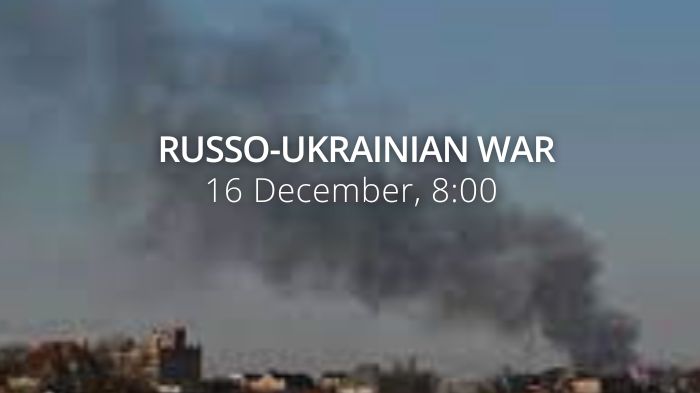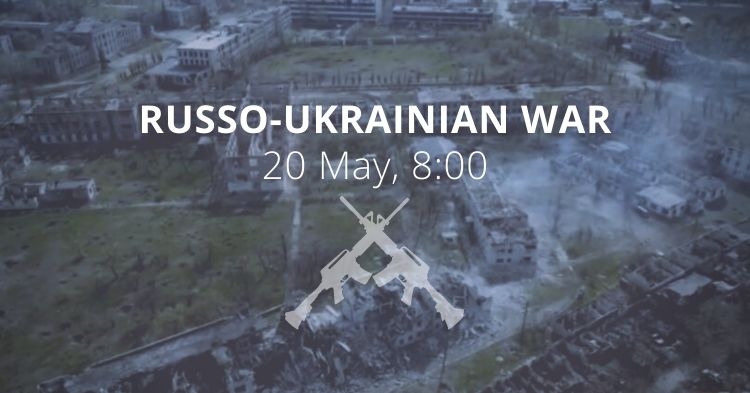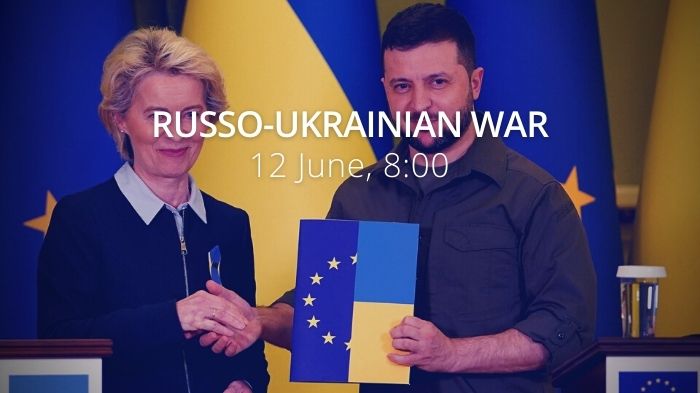Russian attack on a busy pizza restaurant kills 11, including 3 children; 56 injured. Occupiers are returning to positions that were flooded after explosion of Kakhovka HPP. The ongoing Putin-Lukashenka-Prigozhin powerplay is not yet over.
https://twitter.com/EuromaidanPress/status/1674119219699679232
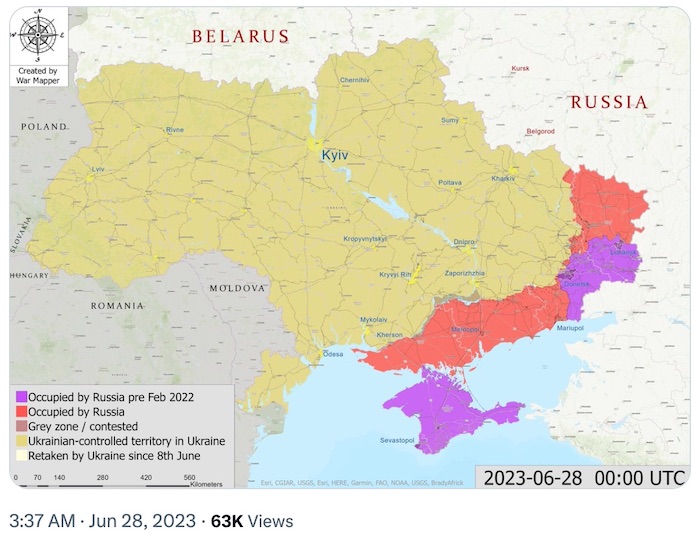
Daily overview — Summary report, June 28
The General Staff’s operational update regarding the Russian invasion as of 18.00 pm, June 28, 2023 is in the dropdown menu below:
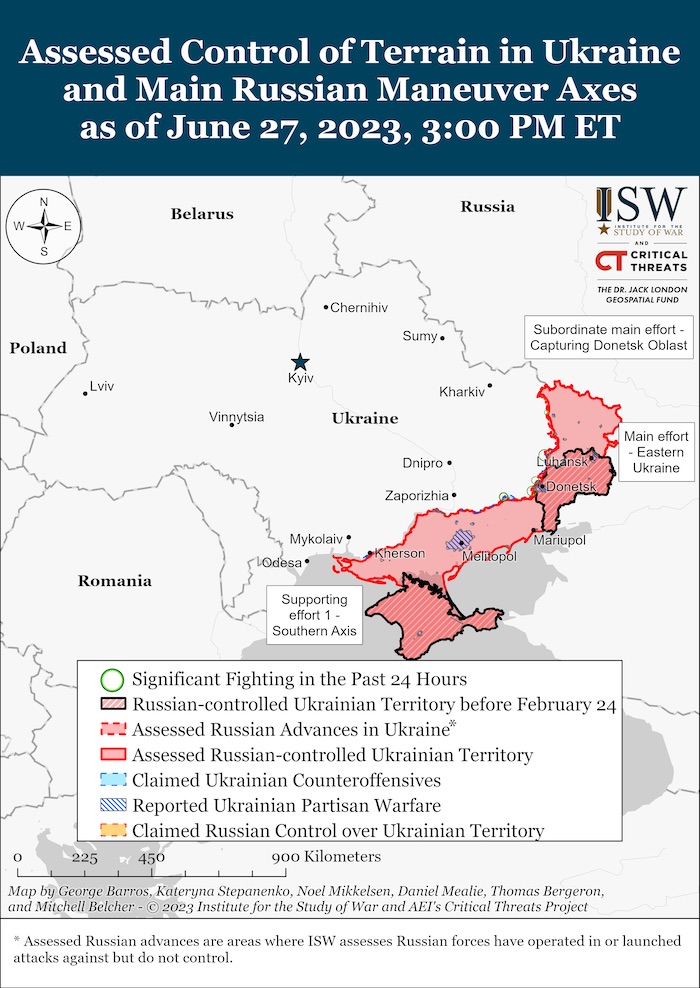
The Russian Federation continues to ignore the laws and customs of war, using terror tactics, striking, and shelling both military and civilian targets.
Last night, the Russian occupiers launched yet another air strike, using Iranian Shahed combat UAVs. Information on the aftermath of this terrorist attack is currently being updated.
On June 27, Russian invaders launched a strike on Ukraine. The strike used 5 Kh-22 air-launched cruise missiles and 2 S-300 anti-aircraft-guided missiles. In addition, the enemy launched 24 airstrikes and 42 MLRS attacks. The enemy fired Kh-22 missiles at a dacha cooperative in Kremenchuk district (Poltava oblast) and Zaporizhzhia. The Russian terrorists used S-300 missiles to hit a catering facility (filled with civilians at the time) in the centre of Kramatorsk and the single-family neighbourhood of the settlement of Bilen’ke (Donetsk oblast). The Russian terrorist attack, unfortunately, killed children and adult civilians, more than 50 civilians were wounded, and apartment buildings and dozens of private homes were damaged.
The likelihood of missile and air strikes across Ukraine remains very high.
The adversary continues to focus its main efforts on Lyman, Bakhmut, and Marinka axes, and the heavy fighting continues. On June 27, there were more than 30 combat engagements.
- Volyn and Polissya axes: no significant changes.
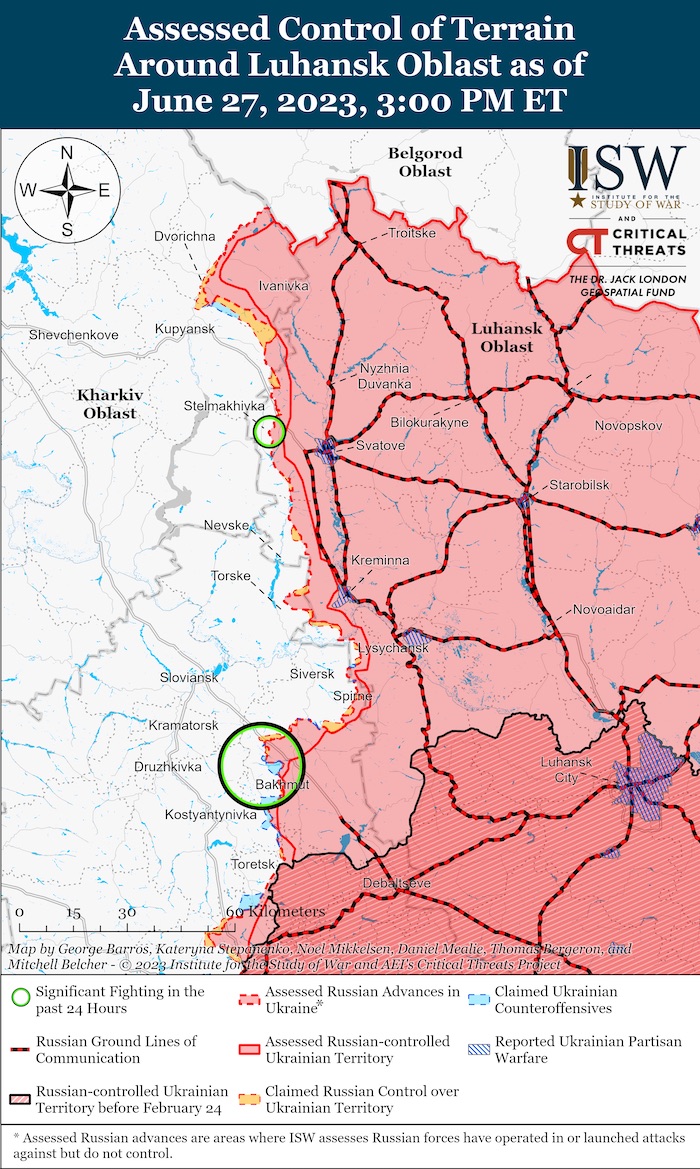
- Sivershchyna and Slobozhanshchyna axes: the adversary fired mortars and artillery at more than 20 settlements, including Zarichchya, Tymonovychi (Chernihiv oblast), Seredyna-Buda, Porokhon’, Fotovyzh, Velyka Pysarivka (Sumy oblast), Udy, Kozacha Lopan’, and Krasne Pershe (Kharkiv oblast).
- Kupiansk axis: the adversary fired artillery and mortars at more than 20 settlements, including Masyutivka, Kyslivka, Kotlyarivka, and Berestove (Kharkiv oblast).
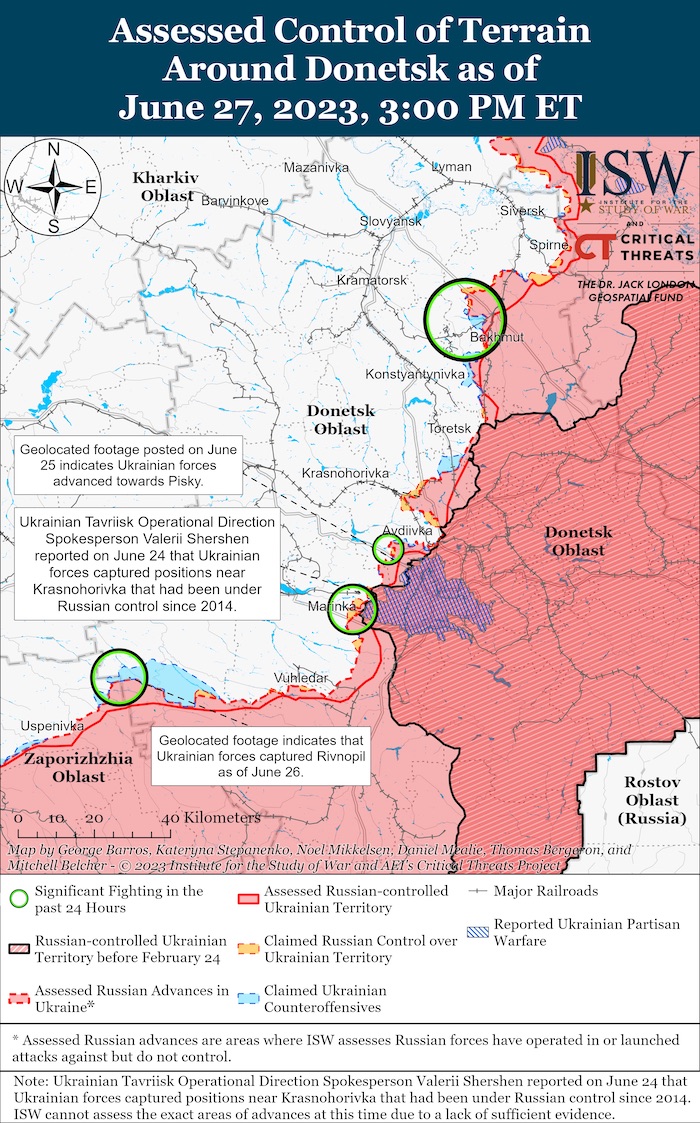
- Lyman axis: the adversary conducted unsuccessful offensives towards Bilohorivka. The enemy fired artillery at more than 15 settlements, including Nevs’ke, Dibrova, Bilohorivka (Luhansk Oblast), Yampolivka, Tors’ke, Serebryanka, and Spirne (Donetsk Oblast).
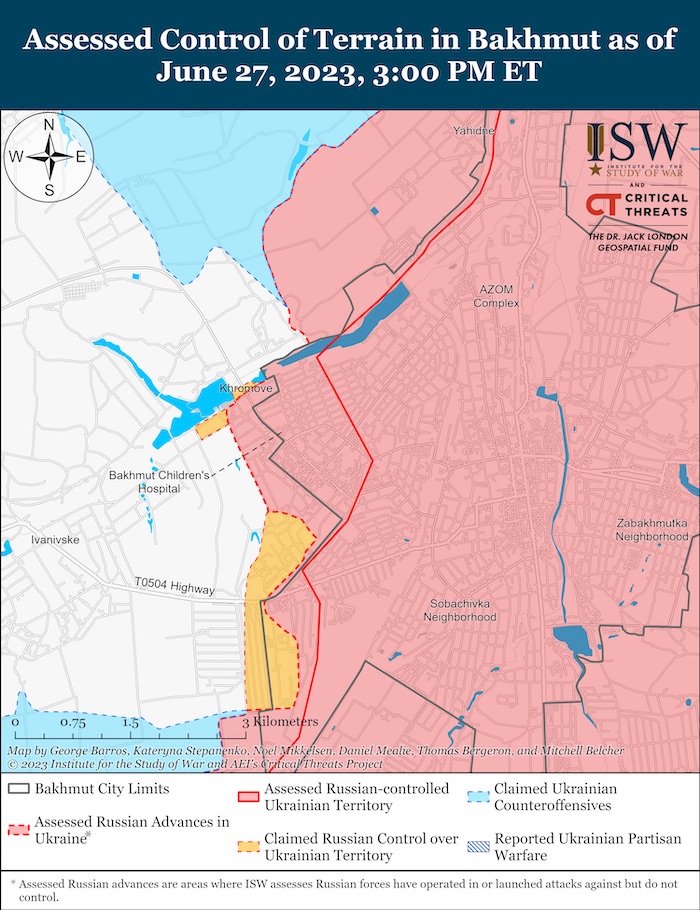
- Bakhmut axis: the enemy conducted offensive operations in the vicinity Orikhovo-Vasylivka, to no success. The enemy shelled the vicinities of more than 15 settlements, including Nykyforivka, Vasyukivka, Rozdolivka, Markove, Khromove, Chasiv Yar, Ivanivske, Ozarianivka, and Pivdenne (Donetsk oblast).
- Avdiivka axis: the enemy launched airstrikes in the vicinity of Avdiivka. The adversary fired artillery at the vicinities of more than 20 settlements, including Keramik, Novokalynove, Avdiivka, Yasnobrodivka, Pervomais’ke, and Nevel’s’ke (Donetsk oblast).
- Marinka axis: the enemy conducted offensive operations in the vicinities of Mar’inka and Pobjeda (Donetsk oblast), to no success. The invaders launched airstrikes near Marinka and Krasnohorivka. At the same time, the occupiers fired artillery at more than 10x settlements, including Mar’inka, Illinka, and Pobjeda (Donetsk oblast).
- Shakhtarske axis: the enemy conducted unsuccessful offensives towards the village of Rivnopil’. The invaders launched airstrikes in the vicinity of Storozheve (Donetsk oblast). The enemy shelled more than 15 settlements, including Katerynivka, Yelyzavetivka, Bohoyavlenka, Blahodatne, Vuhledar, Prechystivka, and Zolota Nyva (Donetsk oblast).
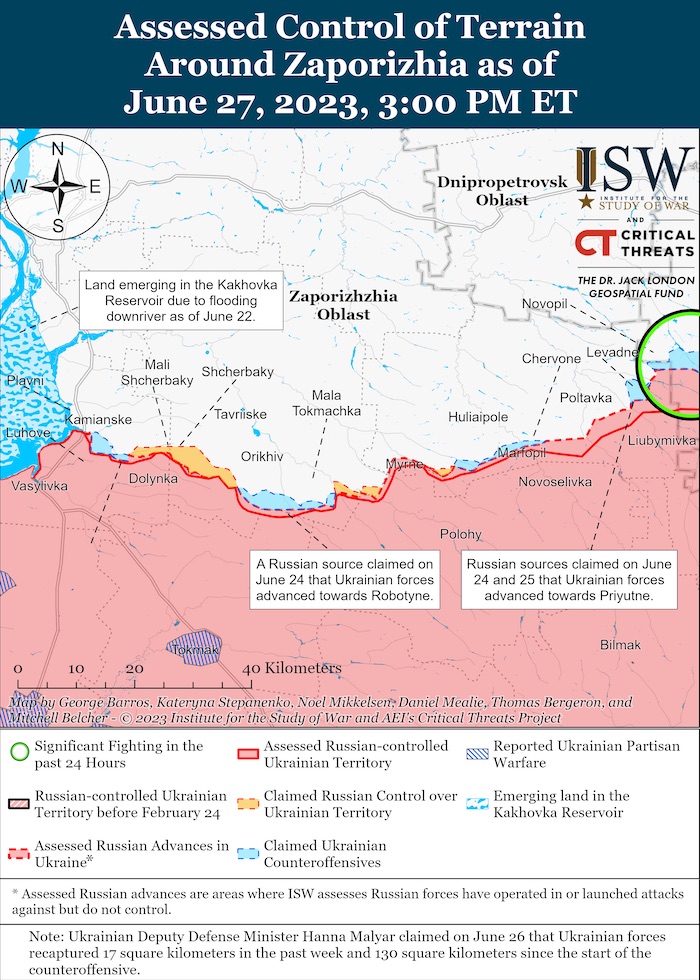
- Zaporizhzhia and Kherson axes: the adversary focuses its main efforts on preventing the advance of Ukrainian troops. The enemy launched airstrikes in the vicinities of Orikhiv and Novodanylivka (Zaporizhzhia oblast). The adversary fired artillery at more than 50 settlements, including Novodarivka, Ol’hivs’ke, Poltavka, Malynivka, Charivne, Mala Tokmachka, Preobrazhenka, Orikhiv, Pavlivka (Zaporizhzhia oblast), Nikopol’ (Dnipropetrovsk oblast), Zolota Balka, Dudchany, Kachkarivka, Vesele, Antonivka, Kherson, Bilozerka, Dniprovs’ke, Kizomys (Kherson oblast), and Ochakiv (Mykolaiv oblast) came under fire.
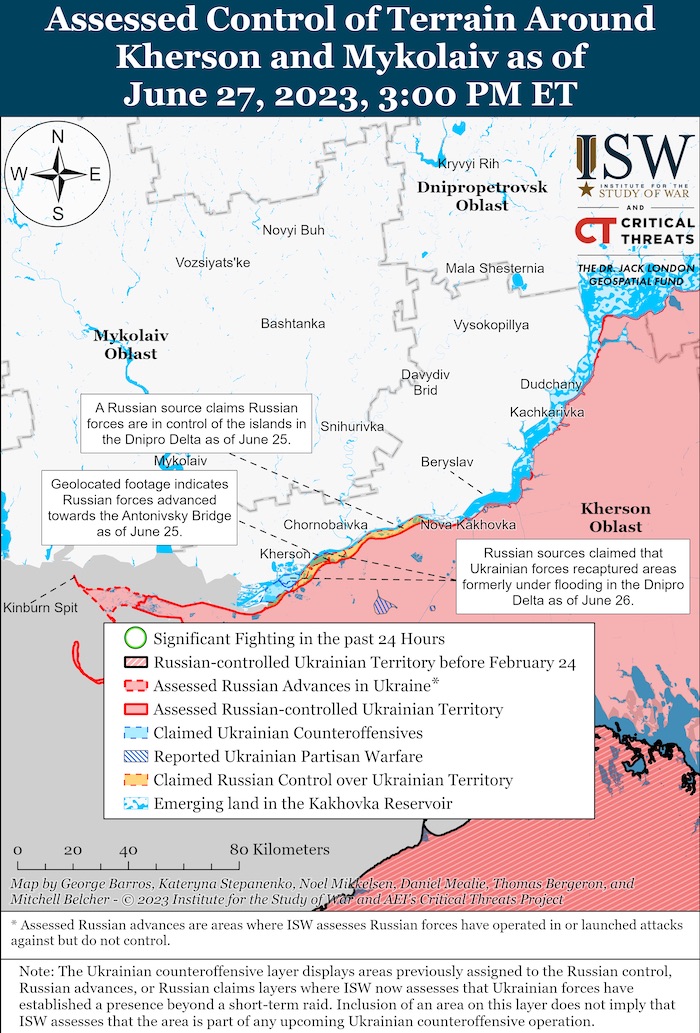
In the settlement of Hornostaivka (Kherson oblast), the occupiers are taking away housing from local residents who have moved to Ukraine-controlled territory or been killed by the hostilities. The stolen housing is labelled with signs “property of the Russian Federation”.
[Continuing the armed aggression, the Russian occupying forces suffer daily losses. About 50 wounded occupiers were brought to the building of a kindergarten converted into a field hospital for the invaders, located in Novomykhailivka, Kherson Region.]
[Also, the enemy continues to convert civilian educational institutions in the temporarily captured territories of Ukraine into medical institutions. Thus, the occupiers turned the secondary school of the Rozhivka settlement of the Zaporizhzhia region into another military hospital. The constant transport of wounded invaders is noted.]
On June 27, Ukrainian Air Force launched 18 air strikes on the concentrations of enemy troops and 6 airstrikes on the anti-aircraft missile systems. Also, the Ukrainian defenders intercepted 6 reconnaissance UAVs.
On June 27, the Ukrainian missile and artillery hit 1 command post, 2 Buk anti-aircraft missile systems, and 4 concentrations of enemy troops, weapons and military equipment.
Military Updates
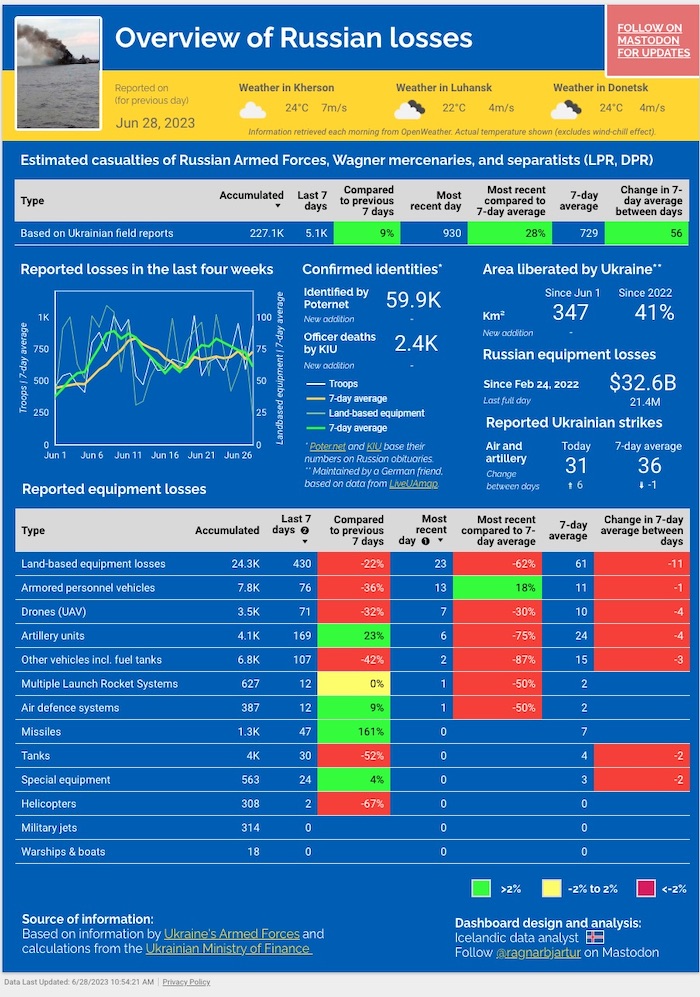
Six Shahed drones were downed over Ukraine last night, Ukrinform reports, citing the Ukrainian Air Force. “On the night of June 28, 2023, the air defence units of the Air Force and other elements of Ukraine’s Defence Forces destroyed six Shahed-136/131 loitering munitions, which were used by Russian occupiers to attack [Ukraine] from the southeastern direction, the report states.
A reminder that, on June 27, 2023, Russian invaders fired five Kh-22 air-launched cruise missiles and two S-300 guided missiles at Ukraine’s territory. The enemy also launched 24 air strikes and opened fire with multiple launch rocket systems (MLRS) 42 times.”
Ukrainian Forces successfully storm Russian positions near Kurdiumivka in Donetsk region, Ukrinform reports, citing the Ukrainian Land Forces Command. "The 1st Mechanized Battalion of the 28th Mechanized Brigade named after the Knights of the Winter Campaign successfully stormed the positions of the invaders near Kurdiumivka, the statement reads. As noted in the command, as a result of the battle, the enemy battalion was defeated - up to 35 were killed, 40 fled, and several invaders surrendered.”
Occupiers are returning to positions that were flooded after explosion of Kakhovka HPP - OC "South", Ukrainska Pravda reports, citing Natalia Humeniuk, the spokeswoman of the OC "Pivden", on the "Svoboda.Ranok" broadcast. “The Russian occupiers are returning to the positions that were flooded as a result of the explosion of the Kakhovka HPP dam, and are trying to set up mortar positions there.
We are recording the return. They are trying to return to these distances that were unreachable for them because of the high water. Where the water recedes, and even where the water has not yet receded. They are trying to get there by boats and deploy their positions. In particular, mortars. On the upper floors of buildings that are not underwater but are located so close that mortar calculations could be used in the shelling of the right-bank Kherson region, Humeniuk said.
The occupiers set up specially equipped positions in residential areas to cover themselves with civilians. This is an insidious practice that they use. Again they hide behind civilian objects, civilian people. Without providing help and without using the boats to help civilians, they use them to move their positions, said the spokeswoman of the OC South.”
Military spox: Terrorist attack on Kakhovka HPP doesn't stop AFU offensive, good results to come soon, Ukrinform reports, citing the Head of the Joint Press Center of the Operational Command "South", Nataliia Humeniuk. "Defence forces have not been affected by this (the explosion of the Kakhovka HPP - ed.) as much as the occupiers expected. Still, there have been some changes in combat operations. However, they fit into the global plan for the advance of the Defence Forces, which scares the occupiers so much, the spokeswoman said.
Thus, Humeniuk noted, the occupiers continue to realize that even such a difficult situation, which they created with a man-made disaster, will not stop the Defence Forces. "We continue our combat work - it is effective and goes according to a previously agreed plan. Very soon there will be results that will please everyone, Humeniuk assured.
In her opinion, the situation at the Zaporizhzhia NPP is one of the key elements in the chain of man-made blackmail by which the enemy is trying to force the international community and the Ukrainian Defence Forces to adjust to their ideas and plans. But this blackmail can be put into action. The enemy has already proved this on the example of the Kakhovka HPP. Here, the scale may be more significant. The international community needs to be involved, emphasized Humeniuk.
Earlier, Kyrylo Budanov, head of the Main Intelligence Directorate of the Ministry of Defense of Ukraine, said that Russian troops had deployed equipment with explosives near four of the six power units at ZNPP.”
Railway track was damaged in Kirovske district of occupied Crimea, Censor.net reports, citing the Crimean traitor Serhii Aksyonov. “A railway track was damaged in the Kirovske district of the temporarily occupied Crimea. He assures that there are no victims, specialized services are working on the spot. Repair works will take approximately 4 to 8 hours. According to "Baza", as a result of an explosion on the "Petrovo-Vladislavivka" track, the first car of a freight train derailed.”
Following Chonhar bridge blast, Russians use route closer to AFU’s positions – Humeniuk, Ukrinform reports, citing the Head of the United Coordinating Press Center of the Southern Defense Forces Natalia Humeniuk. “Now, as logistics operations via the Chonhar direction are complicated, they [Russian invaders – Ed.] have to use the Armiansk direction. But this route is much closer to the positions of Ukraine’s Defense Forces. Thus, they are nervous and cannot use it in full force,” Humeniuk told.
In her words, this situation creates tension in enemy troops, which arises from material problems and moral insecurity. This is a continuation of our counteroffensive, but now it is already in the heads and logistics of the enemy, Humeniuk added.
A reminder that, following the attack on the Chonhar Bridge, connecting the temporarily occupied Crimea and mainland Ukraine, traffic through the bridge was suspended.”
According to British Defence Intelligence, (last 48 hours):
- Early on the morning of 22 June 2023, Ukrainian Armed Forces struck the Chonhar road bridges between the Crimean Peninsula and Russian-occupied Kherson Oblast.
- These bridges service one of two main road supply routes between Crimea and Kherson. The route over the Chonhar bridges is the most direct route from Russia’s Crimean logistics hub at Dzhankoi and the Zaporizhzhia sector, where Russia is currently defending against a major Ukrainian offensive. The temporary closure of the route caused vital Russian logistics convoys to take at least 50% longer to reach the front via alternative routes.
- Reports indicate that Russian authorities almost certainly constructed a pontoon bridge replacement crossing withing 24 hours of the attack; it is highly likely that crossings are limited to military traffic only. The speed with which an alternate crossing was constructed indicates how vital this route is to the Russian military efforts in occupied Ukraine.
- Ukrainian Airborne forces have made small advances east from the village of Krasnohorivka, near Donetsk city, which sits on the old Line of Control.
- This is one of the first instances since Russia’s February 2022 invasion that Ukrainian forces have highly likely recaptured an area of territory occupied by Russia since 2014.
- Recent multiple concurrent Ukrainian assaults throughout the Donbas have likely overstretched Donetsk People’s Republic and Chechen forces operating in this area.
Losses of the Russian army
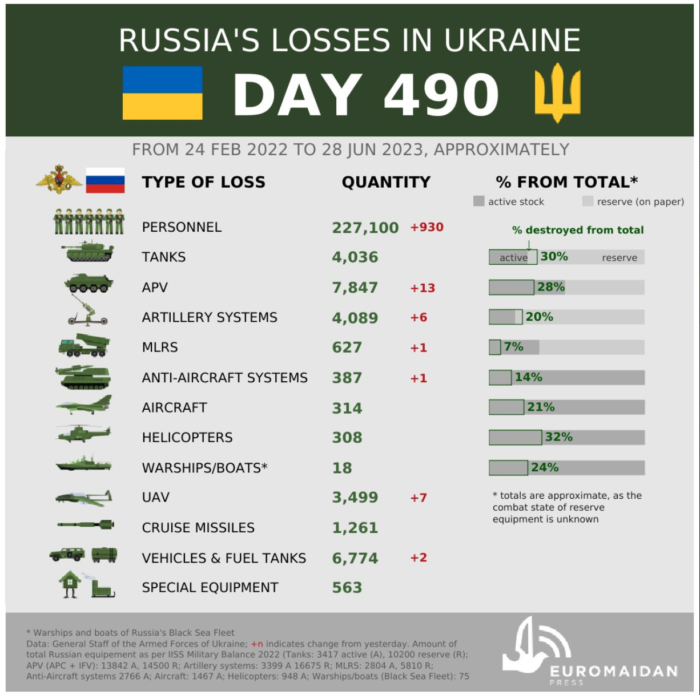
As of Wednesday 28 June, the approximate losses of weapons and military equipment of the Russian Armed Forces from the beginning of the invasion to the present day:
- Personnel – about 227100 (+930)
- Tanks – 4036 (+0)
- Armoured combat vehicles – 7847 (+13)
- Artillery systems – 4089 (+6)
- Multiple rocket launchers –MLRS - 627 (+1)
- Air defence means – 387 (+1)
- Aircraft - 314 (+0)
- Helicopters - 308 (+0)
- Automotive technology and fuel tanks – 6774 (+2)
- Vessels/boats - 18 (+0)
- UAV operational and tactical level – 3499 (+7)
- Special equipment – 563 (+0)
- Mobile SRBM system – 4 (+0)
- Cruise missiles – 1261 (+0)
Ukrainian Air Force shares good and bad news about Kh-22 missiles, Ukrainska Pravda reports, citing Yurii Ihnat, spokesperson for the Ukrainian Air Force. “Since the beginning of the full-scale invasion, Russia has used approximately 140 non-precise Kh-22 missiles for attacks on Ukraine, they are no longer manufactured because they are outdated, but the aggressor state still has these missiles in stock.
These weapons are outdated, they are not high-precision, they are throwing them around densely populated cities, what else can you call it if not terrorism against our nation. In such tension and such terror, Russia is trying to put pressure on Ukraine, wants to break our spirit, force us to make some concessions. They still have enough of those missiles. I would like to remind you that we even handed over these missiles together with Tu-22 aircraft at a time, both in debt for gas and as part of the disarmament of Ukraine...
Unfortunately, Russia still has those missiles, hundreds of units. They have already used about 140 since the beginning of the full-scale invasion. The good news is that the Russians no longer produce these missiles, it is an outdated Soviet missile. In addition to not being manufactured, these missiles very often do not reach their targets (perhaps they are not stored properly). This is one of the positives for us."
Ihnat emphasised that it is almost impossible to shoot down Kh-22 missiles flying along a ballistic trajectory with the usual means of Ukrainian air defence. This missile can be shot down by anti-missile systems such as Patriot, or other systems capable of shooting down ballistics. At the same time, there are few such systems in Ukraine at the moment.”
Lukashenka claims Prigozhin has given up his demands regarding Russia's defence minister and chief of general staff, Ukrainska Pravda reports, citing Belarusian regime-aligned news agency BelTA. “Aliaksandr Lukashenka, the self-proclaimed President of Belarus, has claimed that Yevgeny Prigozhin, leader of the Wagner Group, has finally given up his demands that Russia’s Defence Minister Sergei Shoigu and Chief of General Staff Valery Gerasimov should be dismissed.”
Lukashenka explains what he wants to get out of Wagner Group, Ukrainska Pravda reports, citing Belarusian informational agency BelTA citing Lukashenka at a meeting with the Minister of Defence of the Republic of Belarus, Viktor Khrenin. “The self-proclaimed president of Belarus, Aliaksandr Lukashenka, expects that the Wagner Group commanders will share their experience and help the Armed Forces of the Republic of Belarus improve their skills.”
We are not building camps for Wagnerites, let them set up tents – Lukashenka, Ukrainska Pravda reports. “Aliaksandr Lukashenka, the self-proclaimed president of Belarus, has claimed that they do not build camps for the Wagner Private Military Company (PMC) but will "help with accommodation" if necessary. […]
We offered them one of the abandoned camps. They are welcome – the fence is there, and everything is in place. Put up your tents. We will help them as much as we can until they decide what to get up to.
The Russian media outlet Vyorstka reported that camps were being built in Belarus to house Wagner PMC militants after arrangements were made with Aliaksandr Lukashenka, who was in talks with Yevgeny Prigozhin. The State Border Guard Service of Ukraine denied this information. The SBGS stressed that the intelligence service closely monitors the situation in the country, which is an accomplice of the Russian aggressor state.”
Humanitarian
Russian forces attack civilian infrastructure in Kramatorsk: 4 civilians killed and 42 injured, Ukrainska Pravda reports, citing Andrii Yermak, Head of the Ukrainian President's Office, on Telegram; Kramatorsk City Council; Radio Liberty, Ministry of Internal Affairs, Pavlo Kyrylenko, head of the Donetsk Oblast Military Administration. “On the evening of 27 June, Russian invaders attacked Kramatorsk, Donetsk Oblast, hitting a catering establishment. So far, the media report four people, including a 17-year-old woman were killed, and 42 wounded. Three foreigners are among the wounded.
According to our sources, the Russians used S-300 missile systems to attack the city. Civilians, including a child, have been injured. Andrii Yermak, Head of the President’s Office, later confirmed that the Russians had hit Kramatorsk with two missile strikes. The first hit was recorded on a restaurant in the city centre. The second was on the village of Bilenke.
Kramatorsk City Council reported that the occupiers hit the city centre and a village. They hit a restaurant. Search and rescue operations are now underway. We will be providing updates on these operations, the council said.”
Death toll in Russia’s attack on Kramatorsk rises to eight, 56 people injured , Ukrinform reports, citing the Ukrainian State Emergency Service. “As of 07:00 a.m., June 28, 2023, eight bodies of victims were recovered from under the rubble of the café premises (including three children, two born in 2008 and one in 2011). Fifty-six people were injured (including one child born in 2022). Three people were rescued, the report states.»
Environmental
Political games around the ZNPP. What happens in the face of the threat of a nuclear disaster, the former member of the board of the State Nuclear Regulatory Inspectorate of Ukraine (SNRIU) Olga Kosharna writes in New Voice. “The structures of the UN show a sad callousness and focus on the grain agreement. However, if a disaster occurs at the ZAES, grain from Ukraine will have to be forgotten for centuries. The feeble reaction of the world community to the explosion of the Kakhovskaya HPP dam, the largest man-made disaster in Europe in recent decades with long-term environmental consequences, should activate the information policy of our authorities, in particular, at the diplomatic level and in international organizations. Unfortunately, this did not happen.
The disappearance of the Kakhov reservoir, from which water was supplied for cooling the reactors and spent nuclear fuel storage pools of the ZNPP, increased the risks of serious accidents at the NPP with radiation consequences. The meeting of the UN Security Council on June 23, 2023 became a vivid example of the sorrowful callousness of the world. UN Deputy Secretary-General Rosemary DiCarlo made a speech in which the emphasis was placed on:
- On victims among the civilian population (to date, the Office of the High Commissioner for Human Rights has registered 24,862 victims among the civilian population).
- Blasting of the Kakhovskaya HPP (it was emphasized that the UN and humanitarian partners could not get access to people to help the victims in the occupied part of the Kherson region). […]
- to the Black Sea grain initiative. […]
- Nuclear weapons and regional consequences of war. […]
Ukraine's ambassador to the UN, Serhiy Kyslytsia, expressed concern over the fact that according to intelligence, Russia is considering a scenario of a terrorist attack at the Zaporizhzhia NPP with a radiation leak.
The explosion of the dam made it clear that Russia is ready to use scorched earth tactics in response to a worsening military situation in occupied territories that they doubt they will be able to hold, he said. Kislytsia called on the international community to take seriously the threat of nuclear terror and to increase pressure on the Russian Federation to prevent such a development. In particular, he proposed to introduce strengthened restrictive measures against the Russian nuclear industry and the military-industrial complex. We also expect an objective assessment of Russia's criminal actions by IAEA Director General Rafael Grossi, Kyslytsia said.
Russia's Permanent Representative to the UN, Vasyl Nebenzya, for his part, called the Ukrainian claims that Russia had mined the ZNPP and was preparing to blow it up as paranoid. According to Nebenzi, the IAEA mission led by the director general of the agency, Rafael Grossi, which recently visited the station, could see "their absurdity." Pay attention to how the argument uses the statement of Grossi, who did not notice the mining of the cooling pond (because the mines are at the bottom)! But he does not mention the IAEA's message about mining around the ZNPP and the ZNPP site! […]
The […] representatives of the states concentrated in their speeches, first of all, on the world's food security and the Black Sea grain initiative and the victims of the war, especially children.
At the same time, even before the start of the meeting of the UN Security Council, the IAEA published a weekly report on the events at the ZNPP on its official website. It acknowledged the mining of the area around the ZNPP and the ZNPP site. "The IAEA is aware of reports of mining near the cooling pond. During the visit of the general director, no mines were found on site, including the cooling pond (it is clear that it was not detected, because the mines are at the bottom of the pond - author). However, the IAEA is aware of the prior placement of mines outside the perimeter of the nuclear power plant, which the agency has previously reported, as well as at certain locations inside, which security personnel explained were placed for defensive purposes. “Our assessment of these specific locations was that while the presence of any explosive device would not meet security standards, the basic security functions of the facility would not be significantly affected. We are following this issue with great attention," said IAEA Director General Grossi.
Evaluate the wording: "although the presence of any explosive device does not meet safety standards, the basic safety functions of the facility are not significantly affected" and also: "the placement of mines inside was for defensive purposes." That is, the nuclear terrorist places mines near the systems important for the safety of the nuclear power plant with a "defensive purpose". Who is he defending himself from?! From the staff of ZNPP? And the IAEA writes at the same time that the security functions are not " significantly affected". This is something new in the nuclear and radiation safety standards of the IAEA […]. Further in the text, Grossi calls on all parties to adhere to the IAEA's basic principles aimed at preventing a nuclear accident.
I would like to point out that the post-mission of Ukraine to the IAEA has been silent lately, unlike the Russian Federation, which registers three verbal notes a day regarding the situation at the ZNPP and thus spreads its narratives among the member states. This shows that both NAEC Energoatom and the State Atomic Energy Regulatory Commission do not see any problems in the behavior of nuclear terrorists at the ZNPP and do not write corresponding letters to the Ministry of Foreign Affairs. For example, the pause between Ukrainian notes lasted from June 6 to June 23, 2023.
States that are concerned about food security and the implementation of the Black Sea Grain Initiative should understand that if Russia carries out a terrorist attack on the ZNPP with radiation consequences , a large amount of agricultural land in Ukraine, Russia and neighboring countries may become unsuitable for growing agricultural products for centuries. It is necessary for these states to clearly separate the causes and consequences, but for some reason this is not happening. Preventive measures of consolidated pressure on the terrorist state must be applied immediately. And when Russia carries out its terrorist attack, it will be too late to put pressure on it. Kyrylo Budanov, head of the Ministry of Internal Affairs and Communications, reported that the preparations for the terrorist attack had been completed .
The helplessness of UN structures in the face of an insolent terrorist state during 500 days of full-scale war is obvious. Without a doubt, they need to be dissolved, like the League of Nations in its time, and completely reformatted so that Russia does not have the right to vote in them and becomes an exile.”
Legal
Ombudsman: Ukrainian children held in 57 regions across Russia, Ukrinform reports, siting Ombudsman Dmytro Lubinets. "We officially recorded the residence of Ukrainian children in 57 regions of the Russian Federation. In 16 regions, at least 380 children became victims of forcible transfer to Russian families. Cases of abduction of children by the Russian military in the temporarily occupied territories for the purpose of intimidation, pressure on relatives, and intelligence data collection were recorded also," he said.
Lubinets added: it has been established that Russian service members use pressure or possible violence against children to force adults to work for the benefit of the Russian army or occupation authorities.
Kateryna Rashevska, the lawyer of the Regional Center for Human Rights, informed that, according to their data, the Russians take about 100 children every day starting from June 15, 2023 – sometimes a little less, sometimes several times more – to so-called "re-education" camps.”
Occupiers deporting all political prisoners from Crimea to Russia’s remote regions, Ukrinform reports. "After the completion of the trial procedure and the final conviction of a person, as a rule, up to a very long term of imprisonment, no citizen of Ukraine, no political prisoner convicted in Crimea is left to serve an undeserved punishment in the territory of the peninsula or in the adjacent regions of the Russian Federation. Our compatriots, political prisoners, are sent to very remote regions of Russia. Therefore, it is very difficult to interact with them and to have information about their situation all the time," Refat Chubarov, Chairman of the Mejlis of the Crimean Tatar People, said on the air of the FREEDOM TV channel.
He noted that lawyers, consuls, and diplomats could visit political prisoners before the full-scale invasion, but now the situation has become much worse.”
Support
US provides Ukraine with a new aid package worth $500 million, Censor.net reports, citing a statement from Pentagon. “The United States is providing a new $500 million military aid package to Ukraine. It will include armored vehicles, man-portable air defense systems, and ammunition.
As expected, the new US military assistance package includes additional ammunition for Patriot air defense systems, HIMARS missile systems, as well as Stinger anti-aircraft systems, Javelin and AT-4 anti-tank systems, and anti-tank missiles.
The United States will also provide Ukraine with 30 Bradley infantry fighting vehicles and 25 Stryker armored personnel carriers, HARM high-speed anti-radiation missiles, TOW missiles, precision aerial munitions, an unspecified number of 155-mm and 105-mm artillery shells, small arms and more than 22 million rounds of ammunition.
Other components of the new assistance package include explosive ordnance and demining systems, demining equipment, thermal imaging systems and night vision devices, test and diagnostic equipment to support vehicle maintenance and repair, spare parts, generators and other field equipment.”
Denmark can train up to six Ukrainian pilots on F-16 jets at same time, Ukrainska Pravda reports, citing Reuters, citing Danish Defence Ministry. “Western allies have been developing a programme to train Ukrainian pilots on F-16 fighter jets. The dialogue and planning of this is still ongoing, which is why there is no final plan yet, the Danish Defence Ministry said.
The ministry expects to be able to train up to six Ukrainian pilots at a time, as well as up to 40 support and maintenance personnel. The department could not specify how long it would take to complete the training. It depends on their fighter experience and language skills, the agency added.
Earlier this year, Denmark announced that its F-16 fighter jets would be decommissioned in 2025, two years earlier than planned. This will galvanise the process of transferring them to Ukraine.
The issue of providing Ukraine with F-16 fighter jets was discussed during a meeting of the Ukraine Defense Contact Group (Ramstein-format meeting) last week. Afterwards, the meeting revealed that by July, Ukraine's partners plan to approve a training programme for Ukrainian pilots, technicians and engineers to operate F-16 fighter jets, with the training taking place at a centre created for this specific purpose, in a European country. Politico reports that Ukraine may receive Western F-16 fighter jets in early 2024.”
US Congress calls upon Biden to supply Ukraine with cluster munitions, Ukrainska Pravda reports, citing Foreign Policy. “A bipartisan group of US lawmakers have sent a letter to US President Joe Biden’s Administration, calling upon it to approve the supply of cluster munitions to Ukraine so that Russian defence lines can be breached more effectively. In the letter sent to Biden on Friday, Congress members Joe Wilson, Steve Cohen and Victoria Spartz called upon the White House to send so-called dual-purpose improved cluster munitions (DPICMs) to Ukraine in order to help it conduct the counteroffensive. […]
They also point out that cluster munitions were developed in the US during the Cold War "to counter Russia’s numerical and material superiority. And now they can be put to their intended use in Ukraine’s defence - and Ukraine’s defence of Europe, and ultimately, US national security, the Congress members add.
Cluster munitions usually launch a large quantity of small elements, which can injure and kill the civilian population. These projectiles are also characterised by a high percentage of non-detonation, rendering them dangerous for many more years after an armed conflict is over. Over 120 countries adopted a convention banning the manufacturing, use and storage of cluster munitions in 2008. The US, Russia and Ukraine declined to sign up to it.”
New Developments
Ukraine needs a signal that the country will join NATO after the Russo-Ukrainian war ends, and security guarantees until the accession - Zelenskyyhttps://t.co/b7R7Mg7YOO
— Euromaidan Press (@EuromaidanPress) June 28, 2023
- "Captain in the storm": Stoltenberg to remain NATO Secretary General for another year, Ukrainska Pravda reports, citing Euractiv, citing four NATO countries’ diplomats. “NATO Secretary General Jens Stoltenberg is likely to serve another year in office, despite his repeatedly expressed desire to hand over the leadership to another person. Stoltenberg, who has been NATO Secretary General since October 2014, was expected to resign this autumn, but instead, he may stay on for another year. The decision could be made as early as Wednesday, 28 June. None of Stoltenberg's potential successors, such as Danish Prime Minister Mette Frederiksen, UK Defence Secretary Ben Wallace or Spanish Prime Minister Pedro Sanchez, have so far been able to secure the support of 31 NATO member states.”
- Stoltenberg warns Alliance must not underestimate Russia, calls for further support for Ukraine, Ukrinform “NATO Secretary General Jens Stoltenberg has warned that the Alliance must not underestimate Russia despite the recent events and stressed the importance of providing further support to Ukraine. […] We all saw the events in Russia over the last days. These are internal Russian matters. But what is clear is that President Putin’s illegal war against Ukraine has deepened divisions and created new tensions in Russia. At the same time, we must not underestimate Russia. So it is even more important that we continue to provide Ukraine with our support. And I expect that our Summit in Vilnius will send a clear message of our commitment, Stoltenberg said.”
- There are all grounds for political invitation of Ukraine to NATO, Ukrainska Pravda reports, citing President Zelensky. “President Volodymyr Zelensky held a meeting on preparations for the NATO summit in Vilnius. NATO. Vilnius. Ukraine. There are all grounds for a political invitation of Ukraine to the Alliance. There is a full understanding of security guarantees for Ukraine for the time until the moment of accession.We are working with the team so that the decisions of the summit in Vilnius become really meaningful, the message reads.”
- Chinese ambassador unexpectedly supports Ukraine's desire to liberate Crimea, Ukrainska Pravda reports, citing Fu Cong, in an interview with several media, including Al Jazeera. “Fu Cong, Chinese ambassador to the European Union, has said that he does not rule out Beijing's support for Ukraine's desire to restore its territorial integrity by returning to the borders of 1991. When journalists asked the Chinese diplomat about supporting Ukraine's goals, in particular the return of Ukrainian territories occupied by Russia, he replied, I don’t see why not. We respect the territorial integrity of all countries. So when China established relations with the former Soviet Union, that’s what we agreed on. But as I said, these are historical issues that need to be negotiated and resolved by Russia and Ukraine and that is what we stand for, Fu said.”
- Kremlin says Vladimir Putin's position not 'shaken' by mutiny, Reuters “The Kremlin said on Tuesday it did not agree with what it called the opinion of "pseudo specialists" that an aborted armed mutiny by Wagner mercenaries at the weekend had shaken President Vladimir Putin's position. It has portrayed the Russian leader, in power as either president or prime minister since 1999, as having acted judiciously to avoid what it has called "the worst case scenario" by giving time for talks to yield a deal that ended the mutiny without more bloodshed.”
- Lithuania and Latvia: NATO must step up security of eastern borders now that Wagnerites are in Belarus, Ukrainska Pravda reports, citing Reuters. “On Tuesday, 27 June, the foreign ministers of two Baltic states urged the North Atlantic Alliance to strengthen its eastern borders in response to the deployment of fighters from the Wagner Private Military Company (PMC) in Belarus.”
- FSS closed "armed mutiny" case of PMC "Wagner", net reports, citing Interfax. “The FSS reported that the case "about the armed mutiny" carried out by the leader of the "Wagner" PMC, Yevgeny Prigozhin, was closed. During the investigation of the criminal case based on the fact of armed rebellion, it was established that the participants stopped their criminal activities on June 24, the message says.”
Assessment
https://www.understandingwar.org/backgrounder/russian-offensive-campaign-assessment-june-27-2023*
- On the war.
The Institute for the Study of War has made the following assessment as of June 27, 2022:
Russian and Ukrainian forces continued limited ground attacks northwest of Svatove and south of Kreminna on June 27. The Ukrainian General Staff reported that Russian forces conducted unsuccessful offensive actions near Stelmakhivka (15km northwest of Svatove). A Russian milblogger claimed that elements of the Russian 76th Air Assault (VDV) Division continue advancing in the Kreminna forest area. Another Russian milblogger claimed that Russian forces conducted failed ground attacks near Vesele (30km south of Kreminna) and Rozdolivka (32km southwest of Kreminna). The Russian Ministry of Defense claimed that Russian forces repelled two Ukrainian ground attacks in an unspecified area in the Lyman direction, and a Russian milblogger claimed that Ukrainian forces unsuccessfully attacked near Bilohorivka (10km south of Kreminna) and Spirne (25km south of Kreminna).
Ukrainian officials are signaling that Ukrainian forces are capitalizing on the armed rebellion in Russia and intensifying counteroffensive operations in the Bakhmut area as of June 27. Ukrainian Deputy Defense Minister Hanna Maliar stated that Ukrainian forces considered the Wagner Group-Russian Ministry of Defense (MoD) conflict when planning operations in eastern Ukraine. Maliar stated that Ukrainian forces have conducted counteroffensive operations and made advances on the flanks of Bakhmut for the fourth consecutive day. Maliar stated that the Bakhmut situation is complex because Russian forces occupy extensive fortifications in the city, and that Ukrainian forces will advance more slowly. The Ukrainian Eastern Group of Forces Spokesperson Colonel Serhiy Cherevaty stated that Ukrainian forces have the battlefield initiative in the Bakhmut area. Ukrainian General Staff Spokesperson Andriy Kovalev stated that Ukrainian forces continue offensive operations in the Orikhovo-Vasylivka (11km northwest of Bakhmut), Ivanivske (6km west of Bakhmut), Kurdyumivka (14km southwest of Bakhmut), and Pivnichne (20km southwest of Bakhmut) areas on Bakhmut’s flanks. A prominent Russian milblogger characterized the Russian military situation north of Soledar as ”grave” and stated that Ukrainian forces are counterattacking towards Yakovlivka (14km northeast of Bakhmut).A Russian milblogger claimed that Ukrainian forces conducted unsuccessful counterattacks southwest of Bakhmut near Klishchiivka (7km southwest of Bakhmut) and Kurdyumivka.
Russian forces continued limited ground attacks and advanced in the Bakhmut area as of June 27. Geolocated footage posted on June 27 indicates that Russian forces likely reduced Ukrainian tactical gains near Berkhivka (6km north of Bakhmut) as of June 27, though it is unclear when Russian forces made these gains. A Russian milblogger claimed that Russian forces launched unsuccessful ground attacks from their positions in Berkhivka and Dubovo-Vasylivka (6km northwest of Bakhmut), as well as in the direction of Mynkivka (13km northeast of Bakhmut). The Ukrainian General Staff reported that Russian forces conducted unsuccessful ground attacks near Bohdanivka (5km northwest of Bakhmut) and Ivanivske.
Russian forces continued limited ground attacks on the Avdiivka-Donetsk City line on June 27. The Ukrainian General Staff reported that Russian forces conducted unsuccessful ground attacks near Pervomaiske (6km southwest of Avdiivka) and Marinka (immediately southwest of Donetsk City). Russian state media outlet RT claimed that Russian forces in Marinka are making gradual advances and that advancing Russian infantry occasionally order artillery strikes against Ukrainian positions 15 to 20 meters away from their own positions.
Ukrainian forces have reportedly made marginal advances in areas that Russian proxy forces have occupied since 2014. The UK MoD reported that Ukrainian forces have made marginal advances east of Krasnohorivka (immediately west of Donetsk City) as of June 27, the first reported instance of Ukrainian forces recapturing territory occupied before 2014. ISW has not observed independent confirmation of Ukrainian forces recapturing long-occupied territory, however. The UK MoD assessed that recent Ukrainian attacks have likely overstretched Donetsk People’s Republic (DNR) and Chechen forces operating in Donetsk Oblast.
Ukrainian forces continued counter-offensive operations in the Donetsk-Zaporizhzhia oblasts’ administrative border area on June 27. Ukrainian General Staff Spokesperson Andrii Kovalev stated that Ukrainian forces conducted successful counteroffensive operations in the Novodarivka-Pryyutne (Velyka Novosilka) direction. […] A Russian source reported that Ukrainian forces conducted unsuccessful attacks near Novodonetske (11km southeast of Velyka Novosilka) and Urozhaine (9km south of Velyka Novosilka). […] Russian sources claimed that heavy fighting is ongoing near the Vremivka salient and warned that if Ukrainian forces advanced further, they will likely be able to cut off the Vremivka salient. A Russian milblogger expressed concern that Ukrainian forces are preparing for further offensives in the south Donetsk direction despite bad weather. The Ukrainian General Staff reported that Russian forces conducted unsuccessful offensive operations in the Rivnopil direction. Russian Eastern Group of Forces Spokesperson Oleg Chekhov claimed that Russian forces destroyed a Ukrainian unit near Storozheve (3km south of Velyka Novosilka). A Russian milblogger claimed that Russian forces unsuccessfully attacked near Novodarivka (14km southwest of Velyka Novosilka). A Kremlin-affiliated milblogger acknowledged Ukrainian liberation of Rivnopil and claimed that Ukrainian forces made additional gains in the Rivnopil area.
Russian and Ukrainian forces continued limited ground attacks in western Zaporizhzhia on June 27. Kovalev stated that Ukrainian forces conducted successful counteroffensive operations in the Novodanylivka-Robotyne (Orikhiv) direction. […] Rogov claimed that Russian forces stopped a Ukrainian sabotage and reconnaissance group in the Myrne (17km southwest of Orikhiv) area.[] Rogov claimed that Ukrainian forces renewed attacks near Robotyne to regain control of the previously liberated Ukrainian positions north of the settlement that Russian forces recaptured on June 26. Russian milbloggers claimed that Pyatykhatky (25km southwest of Orikhiv) remains in the contested ”grey zone” and that positional fighting is ongoing near the settlement. Geolocated footage published on June 27, however, shows the Russian 429thMotorized Rifle Regiment (19th Motorized Rifle Division, 58th Combined Arms Army, Southern Military District) striking Ukrainian positions in Pyatykhakty. Rogov published footage on June 27 that purportedly shows elements of the Russian 291st Motorized Rifle Regiment (42nd Motorized Rifle Division, 58th Combined Arms Army, Southern Military District) operating near Robotyne.
Russian milbloggers expressed concern at Ukrainian attempts to advance south of Kherson City. A Kremlin-affiliated milblogger claimed that Ukrainian forces are trying to expand their "bridgehead” near the Antonivsky Bridge on east (left) bank Kherson Oblast. ISW currently makes no assessment on the extent to which Ukrainian forces have established a bridgehead in this area, noting only that we assess that Ukrainian forces have established and hold positions of some sort on the east (left) bank. Geolocated footage posted on June 26 showed Russian armored personnel carriers, reportedly from the 7th Guards Mountain Air Assault (VDV) Division, operating near the Antonivsky Bridge. Another milblogger noted that Russian VDV elements struck Ukrainian positions near the Antonivsky Bridge with missiles and used a Russian TOS-1 thermobaric artillery system on the night of June 26. The milblogger claimed that the destruction of the Nova Kakhovka Hydroelectric Power Plant (KHPP) dam is providing Ukrainian forces with freedom of movement but that Russian forces continue to repel Ukrainian advances. The Ukrainian General Staff acknowledged that Russian forces conducted airstrikes in the Oleshky area, which may suggest that Ukrainian forces are conducting some operations in the area.
A Russian source claimed that Ukrainian forces continue to target Crimea with drones. A Russian milblogger claimed Russian air defenses destroyed a Ukrainian drone carrying explosives near Dzhankoi.
Russian President Vladimir Putin is trying to present Wagner Group financier Yevgeny Prigozhin as corrupt and a liar to destroy his reputation among Wagner personnel and within Russian society. Putin implied on June 27 that “the owner of Concord company” (the Concord company is the parent company of Prigozhin’s catering company) lied about the Wagner Group private military company’s (PMC) independence from the Kremlin and the lack of state compensation for Wagner personnel. Putin publicly claimed for the first time since Wagner’s founding that the Kremlin “fully funds” and “fully supplies” the Wagner PMC and claimed that the Kremlin made various payments to Wagner personnel and their families from Russia’s federal budget. Putin added that “the owner of the Concord Company” received 80 billion rubles (about $936 million) between May 2022 and May 2023 for delivering and catering food to the Russian military, and that the Kremlin will investigate whether the company stole anything during its work for the Kremlin. Putin was clearly referring to Prigozhin, who is the owner of the Concord Company Group and previously worked as Putin’s personal caterer, but Putin continues to refuse to say Prigozhin’s name. Putin’s insinuation that the Kremlin will investigate the Concord Company may be preparation to justify the Kremlin’s confiscation of Prigozhin’s assets via corruption charges.
Putin is rhetorically separating Prigozhin from the Wagner PMC and is deliberately depriving Prigozhin of the title of Wagner financier to undermine his role in the Wagner PMC. The Kremlin launched an ongoing domestic information campaign in Russia to forgive Wagner fighters and commanders in an effort to lure Wagner personnel to sign contacts with the Russian Ministry of Defense (MoD). The deliberate effort to separate Prigozhin from the Wagner Group is likely intended to set informational conditions so that the Kremlin can accuse Prigozhin of corruption or conspiring with Ukraine or the West and alienate Prigozhin from Wagner personnel whom the Kremlin seeks to retain to fight in Ukraine as part of the regular Russian military. Prigozhin had built his personal brand on criticizing the Russian military command and bureaucrats for corruption and ties to Western countries, and Putin is likely attempting to shatter Prigozhin’s populist appeal by accusing him of the same sins.
Putin has likely decided that he cannot directly eliminate Prigozhin without making him a martyr at this time. Prigozhin still retains some support within Russian society and the Russian regular forces, and the Kremlin will need to ensure that these groups become disillusioned with Prigozhin to effectively deprive him of his popular support in Russia. Prigozhin campaigned for military command changes by accusing the Russian MoD of mistreating regular Russian military personnel in combat – a message that likely appealed to many servicemen and their families disillusioned with mobilization, casualties, supply shortages, and great loss of life with little to show for it. The Kremlin needs to separate Prigozhin’s cause from his persona, lest an attack on Prigozhin be perceived as a Kremlin attack on his popular narrative and his stated objectives of punishing the criminally incompetent Russian MoD leadership. The Kremlin will likely continue to attack Prigozhin’s character to break Prigozhin’s popular support, discourage Wagner personnel from following him to Belarus, and destroy his financial power.
Belarusian President Aliaksandr Lukashenka’s account of his mediation between Putin and Prigozhin on June 24-25 in tandem with Putin’s June 26 speech indicates that Putin promised Lukashenka and Prigozhin that Prigozhin and the Wagner Group would have “security guarantees” in Belarus. Lukashenka indicated on June 27 that Putin “promised” both Lukashenka and Prigozhin that Prigozhin and the Wagner Group would enjoy unspecified “security guarantees” in Belarus. The Russian Federal Security Service (FSB) officially dropped charges against Prigozhin on June 27. Lukashenka has thus likely managed to secure a degree of safe haven for Prigozhin in Belarus at this time. This is a change in ISW’s June 26 assessment that the offer of safe haven in Belarus was likely a trap. ISW has altered its assessment based on the pattern created by Putin’s and Lukashenka’s speeches.
It is unclear whether Prigozhin’s safety will survive Putin’s effort to destroy Prigozhin’s reputation, however, especially since the threat of corruption investigations against Prigozhin opens the possibility of new charges against Prigozhin that Putin’s promise presumably does not cover. Putin thus likely decided to destroy Prigozhin’s reputation and possibly strip him of his financial resources for offenses technically independent of the armed rebellion while abstaining from punishing Prigozhin directly for the rebellion.
Lukashenka likely seeks to use the Wagner Group in Belarus to buy maneuvering space to balance against the Kremlin campaign to absorb Belarus via the Union State. Lukashenka described at length how he inserted himself into the Putin-Prigozhin conflict in a way that - if Lukashenka’s account is true - demonstrates that Lukashenka is a politically savvy actor capable of exercising influence within the upper echelons of Russian politics. Lukashenka described how he managed to broker the deal between Putin and a livid Prigozhin, who refused to answer Putin’s phone calls, by skillfully engaging both parties directly and through Russian Deputy Defense Minister Yunus-Bek Yevkurov and Russian FSB Director Alexander Bortnikov. Lukashenka’s elaborate account suggests that Lukashenka successfully mediated a crisis within Putin‘s own inner circle that Putin could not. Lukashenka intervened to mediate likely in part to signal to Putin and other senior Kremlin officials that Moscow should not trifle with Lukashenka and that Lukashenka has the ability to operate successfully and independently within Russian politics. Lukashenka’s boasting about his ability to manipulate power brokers within Putin’s innermost circle is humiliating for Putin, whether or not it is true. The fact that Putin has not challenged Lukashenka’s presentation of events and has in fact publicly thanked Lukashenka is even more humiliating.
Lukashenka likely seeks to closely control any Wagner Group forces that move into Belarus. Lukashenka stressed that the Wagner Group will not open recruitment centers in Belarus as it did in Russia but that Belarusians - and presumably other nationals- will be allowed to join the Wagner Group in Belarus. Lukashenka’s description suggests that the Wagner Group will primarily act as a training and advisory partner for the Belarusian military. Lukashenka stated that Wagner forces have more training than the Belarusian military and that the Belarusian military could benefit from the Wagner Group’s extensive combat experience. Lukashenka denied claims that Belarusian authorities have already begun establishing field camps for Wagner Group fighters but said Belarus would create camps if Wagner requested them.
Lukashenka may seek to use the Wagner Group in Belarus to reduce the Belarusian military’s accumulated structural dependency on the Russian military for higher operational functions. Lukashenka may seek to use the Wagner Group to help rebuild lost capability within the Belarusian military that the Belarusian military largely delegated to the Russian Western Military District. The Belarusian military’s dissolution of its unified ground command in 2011 effectively subordinated Belarus’ military to the Western Military District. Belarus has no recent experience in conducting large-scale operations or organizing exercises above the battalion level. Belarus’ main source of knowledge and experience for higher operational activity is from Russian-organized exercises, such as the recurring Zapad, Union Shield, and Unbreakable Brotherhood exercises. The Wagner Group has experience conducting combined arms operations with formations larger than the combat services of the Belarusian military. It is unclear how successful this assessed effort may be, however. The Belarusian military’s operational subordination to the Russian General Staff has been a de facto reality for many years, and reversing such deep institutional linkages will be difficult, if even possible. Russia’s new regime stability crisis may provide novel opportunities for Minsk, nonetheless.
Lukashenka also announced on June 27 that Belarus had received an unspecified number of Russian nuclear weapons on a previous date – a development that Lukashenka may also use to balance against the Kremlin’s campaign to absorb Belarus via the Union State. Belarusian opposition railway workers claimed on June 27 that Russian nuclear weapons will be delivered to the base of the 2631st Missile and Air Ammunition Storage Base in Prudok, Vitebsk Oblast. Lukashenka observed on June 27 that nobody has gone to war with a nuclear power and insinuated that Belarus will use nuclear weapons if a hostile state attacks Belarus. This development is more interesting for how Lukashenka may use the deployment of nuclear weapons in Belarus to posture against Russia than because of any threat nuclear weapons in Belarus pose to NATO or Ukraine. Lukashenka may use the deployment of Russian tactical nuclear weapons in Belarus in tandem with a new Wagner Group presence in Belarus to argue that Belarus has a new capacity to defend itself independent of Russia and that additional Russian basing in Belarus is therefore unnecessary. An indicator of this course of action will be whether Lukashenka allows more Russian military personnel to train at Belarusian training grounds. Ukrainian officials stated that there were approximately 1,000 Russian military personnel in Belarus as of early June 2023 – a sharp decrease from spring 2023 when Ukrainian officials reported that about 9,000-10,000 Russian troops were in Belarus as of March 30. Another indicator would be an explicit promise or rejection of permanent Russian ground forces bases in Belarus.
The ongoing Putin-Lukashenka-Prigozhin powerplay is not yet over and will continue to have short-term and long-term consequences that may benefit Ukraine. Director of the Russian National Guard (Rosgvardia) Viktor Zolotov announced on June 27 that Rosgvardia will receive heavy weapons and tanks. The announcement indicates that the Kremlin is attempting to address regime security issues that transpired during Prigozhin’s armed rebellion on June 24 – such as Russia’s security forces’ inability or unwillingness to repel a mechanized drive on Moscow. The transfer of heavy military equipment to Rosgvardia for internal security will tie up weapons that could otherwise be used in Ukraine. The Russian MoD also announced on June 27 preparations to transfer the Wagner Group’s heavy military equipment to unspecified elements of the Russian Armed Forces. This transfer will deprive Wagner forces of organic heavy mechanized equipment and suggests that the Russian MoD seeks to dissolve previously separate Wagner units, atomize Wagner Group fighters, and integrate them into regular Russian units to minimize the risk of any repeated Wagner-driven mutiny attempts. The announced transfer of Wagner’s equipment to MoD elements also suggests that Wagner forces are unlikely to imminently deploy to reinforce frontlines in Ukraine before undergoing reorganization.
It remains unclear whether the Russian MoD will dissolve Wagner detachments and reassign Wagner personnel to pre-existing regular units. Such a drastic reorganization would be tantamount to the dissolution of the Wagner Group in Ukraine as a distinct organizational entity and would eliminate the unique combat power that the Wagner Group developed for itself in Ukraine. A Russian MoD decision to maintain separate Wagner units within the MoD structure would pose stability risks when subordinating previously independent and overindulged Wagner forces under the MoD highly bureaucratic military command. Separate Wagner forces would likely continue to pose an internal threat to Russia due to their dissatisfaction with the Russian military command – the reason why Wagner forces followed Prigozhin into the armed rebellion in the first place.
The Kremlin campaign to destroy Prigozhin’s reputation and possibly dissolve the Wagner Group’s Ukraine force decreases the probability of Putin announcing a new round of reserve mobilization in the near term. The Russian MoD will be preoccupied with subordinating Wagner forces if many of them elect to sign contracts with the MoD. Putin, who is a cautious decisionmaker and has clearly signaled his concern for his regime, is also unlikely to aggravate Russian society with a highly unpopular mobilization announcement on the heels of the armed rebellion. The Kremlin’s response to the aftermath of Prigozhin’s armed rebellion points to more advantageous conditions for Ukraine compared with the pre-June 24 situation.
Ukrainian forces conducted counteroffensive operations on at least four sectors of the front and reportedly made gains on June 27. Ukrainian President Volodymyr Zelensky reported that Ukrainian forces advanced in all active sectors of the front from Donetsk to Zaporizhzhia oblasts. Russian sources, including the Russian Ministry of Defense (MoD), claimed that Ukrainian forces continued limited ground attacks near and south of Kreminna. Ukrainian and Russian sources reported that Ukrainian forces continued counteroffensive operations on the northern and southern flanks of Bakhmut. Ukrainian General Staff Spokesperson Andriy Kovalev stated that Ukrainian forces conducted successful offensive operations south of Velyka Novosilka near the Donetsk-Zaporizhzhia oblasts administrative border and south of Orikhiv in western Zaporizhzhia Oblast. Russian sources claimed that Ukrainian forces conducted ground attacks south and southeast of Velyka Novosilka, and one prominent milblogger claimed that Ukrainian forces made further gains south of Rivnopil (10km southwest of Velyka Novosilka) after capturing the settlement on June 26. Zaporizhzhia Oblast occupation official Vladimir Rogov claimed that Ukrainian forces conducted counterattacks south of Orikhiv to regain lost positions.
Russian President Vladimir Putin identified the Ukrainian main counter-offensive effort on June 27, possibly signaling his own defensive priority. Putin claimed that Ukraine considers the Orikhiv direction in western Zaporizhzhia Oblast as “the main direction of attack.” ISW offers no assessment of the accuracy of Putin’s statement or of which sector Ukraine has prioritized or plans to prioritize as the main counteroffensive effort. Putin may have instead identified the sector of the front that he perceives as most critical to hold, however. ISW has observed the most extensive Russian defensive fortifications erected in the western Zaporizhzhia Oblast south of Orikhiv.
Key Takeaways
- Russian President Vladimir Putin is trying to present Wagner Group financier Yevgeny Prigozhin as corrupt and a liar to destroy his reputation among Wagner personnel and within the Russian society.
- Belarusian President Aliaksandr Lukashenka’s account of his mediation between Putin and Prigozhin on June 24-25 in tandem with Putin’s June 26 speech indicates that Putin promised Lukashenka and Prigozhin that Prigozhin and the Wagner Group would have “security guarantees” in Belarus.
- Lukashenka likely seeks to use the Wagner Group in Belarus to buy maneuvering space to balance against the Kremlin campaign to absorb Belarus via the Union State and likely seeks to closely control any Wagner Group forces that move into Belarus.
- Lukashenka also announced on June 27 that Belarus had received an unspecified number of Russian nuclear weapons on a previous date – a development that Lukashenka may also use to balance against the Kremlin’s campaign to absorb Belarus via the Union State.
- The ongoing Putin-Lukashenka-Prigozhin powerplay is not yet over and will continue to have short-term and long-term consequences that may benefit Ukraine.
- The Kremlin campaign to destroy Prigozhin’s reputation and possibly dissolve the Wagner Group’s Ukraine force decreases the probability of Putin announcing a new round of reserve mobilization in the near term.
- Ukrainian forces conducted counteroffensive operations on at least four sectors of the front and reportedly made gains on June 27.
- Russian President Vladimir Putin identified the Ukrainian main counteroffensive effort on June 27, possibly signaling his own defensive priority.
- Russian and Ukrainian forces continued limited ground attacks northwest of Svatove and south of Kreminna.
- Ukrainian officials are signaling that Ukrainian forces are capitalizing on the armed rebellion in Russia and intensifying counteroffensive operations in the Bakhmut area as of June 27.
- Ukrainian forces continued counteroffensive operations in the Donetsk-Zaporizhzhia oblasts’ administrative border area.
- Russian milbloggers expressed concern at Ukrainian attempts to advance south of Kherson City.
- Russian officials expressed varied opinions on the future of private military companies (PMCs) in response to the armed rebellion.
The UN reported that Russia has detained hundreds of Ukrainian civilians since the start of the war in Ukraine.
Ukraine defence minister says main troop reserves yet to be used – FT, Reuters reports. “The liberation of a group of villages under Russian occupation in recent weeks were not the main event in Kyiv's planned attack, Oleksiy Reznikov, Ukraine defence minister, told the Financial Times. When it happens, you will all see it... Everyone will see everything, he told FT in an interview published on Wednesday, brushing aside media coverage of slow progress against well-fortified Russian positions.
Ukraine's main troop reserves, including most brigades recently trained in the West and equipped with modern NATO tanks and armoured vehicles, have yet to be used in the operation, Reznikov said.”
Ukraine recaptures more territory in summer than Russia seizes during winter – Wallace, Ukrinform reports, citing the UK Ministry of Defense on Twitter. "As part of their summer campaign to reclaim illegally occupied territory, Ukraine has already recaptured approximately 300 square-km. That’s more territory than Russia seized in its whole winter offensive, UK Defence Secretary Ben Wallace said.”
Russian General Knew About Mercenary Chief’s Rebellion Plans, US Officials Say, The New York Times reports. “Øverst i skjemaet
Nederst i skjemaet
A senior Russian general had advance knowledge of Yevgeny Prigozhin’s plans to rebel against Russia’s military leadership, according to US officials briefed on American intelligence on the matter, which has prompted questions about what support the mercenary leader had inside the top ranks.
The officials said they are trying to learn if Gen. Sergei Surovikin, the former top Russian commander in Ukraine, helped plan Mr. Prigozhin’s actions last weekend, which posed the most dramatic threat to President Vladimir V. Putin in his 23 years in power. General Surovikin is a respected military leader who helped shore up defenses across the battle lines after Ukraine’s counteroffensive last year, analysts say. He was replaced as the top commander in January but retained influence in running war operations and remains popular among the troops.
American officials also said there are signs that other Russian generals may also have supported Mr. Prigozhin’s attempt to change the leadership of the Defense Ministry by force. Current and former US officials said Mr. Prigozhin would not have launched his uprising unless he believed that others in positions of power would come to his aid.
If General Surovikin was involved in last weekend’s events, it would be the latest sign of the infighting that has characterized Russia’s military leadership since the start of Mr. Putin’s war in Ukraine and could signal a wider fracture between supporters of Mr. Prigozhin and Mr. Putin’s two senior military advisers: Sergei K. Shoigu, the minister of defense, and Gen. Valery V. Gerasimov, the chief of general staff. Mr. Putin must now decide, officials say, whether he believes that General Surovikin helped Mr. Prigozhin and how he should respond.
On Tuesday, the Russian domestic intelligence agency said that it was dropping “armed mutiny” criminal charges against Mr. Prigozhin and members of his force. But if Mr. Putin finds evidence General Surovikin more directly helped Mr. Prigozhin, he will have little choice but to remove him from his command, officials and analysts say.
Some former officials say Mr. Putin could decide to keep General Surovikin, if he concludes he had some knowledge of what Mr. Prigozhin had planned but did not aid him. […] Senior American officials suggest that an alliance between General Surovikin and Mr. Prigozhin could explain why Mr. Prigozhin is still alive, despite seizing a major Russian military hub and ordering an armed march on Moscow.
American officials and others interviewed for this article spoke on the condition of anonymity to discuss sensitive intelligence. They emphasized that much of what the United States and its allies know is preliminary. US officials have avoided discussing the rebellion publicly, out of fear of feeding Mr. Putin’s narrative that the unrest was orchestrated by the West.
Still, American officials have an interest in pushing out information that undermines the standing of General Surovikin, whom they view as more competent and more ruthless than other members of the command. His removal would undoubtedly benefit Ukraine, whose Western-backed troops are pushing a new counteroffensive that is meant to try to win back territory seized by Moscow. […]
General Surovikin spoke out against the rebellion as it became public on Friday, in a video that urged Russian troops in Ukraine to maintain their positions and not join the uprising. […] But one former official called that message akin to “a hostage video.” General Surovikin’s body language suggested he was uncomfortable denouncing a former ally, one who shared his view of the Russian military leadership, the former official said.
There were other signs of divided loyalties in the top ranks. Another Russian general — Lt. Gen. Vladimir Alekseyev — made his own video appeal, calling any actions against the Russian state a stab in the back of the country and president. But hours later, he surfaced in another video, chatting with Mr. Prigozhin in the Russian city of Rostov-on-Don, where Wagner fighters seized military facilities.
There were just too many weird things that happened that, in my mind, suggest there was collusion that we have not figured out yet, Michael McFaul, a former US ambassador to Russia, said in a phone interview. Think of how easy it was to take Rostov, Mr. McFaul said. There are armed guards everywhere in Russia, and suddenly, there’s no one around to do anything?
Independent experts, and US and allied officials said that Mr. Prigozhin seemed to believe that large parts of Russia’s army would rally to his side as his convoy moved on Moscow. Former officials said General Surovikin did not support pushing Mr. Putin from power but appears to have agreed with Mr. Prigozhin that Mr. Shoigu and General Gerasimov needed to be relieved of duty. […]
General Surovikin and Mr. Prigozhin have both brushed up against Mr. Shoigu and General Gerasimov over tactics used in Ukraine. While the Russian military’s overall performance in the war has been widely derided as underwhelming, analysts have credited General Surovikin and Mr. Prigozhin for Russia’s few successes. In General Surovikin’s case, that limited success was the professionally managed withdrawal of Russian troops from Kherson, where they were nearly encircled last fall and cut off from supplies. Based on communications intercepts, US officials concluded that a frustrated General Surovikin represented a hard-line faction of generals intent on using the toughest tactics against Ukrainians.
Similarly, Mr. Prigozhin’s Wagner mercenaries achieved some success in taking the eastern city of Bakhmut after a nine-month.”
- Consequences and what to do?
Appeal of Ukrainian Civil Society Organizations to NATO Leaders ahead of Vilnius Summit, European Pravda reports. “The NATO Summit in Vilnius is approaching. The Alliance will have the opportunity to make a historic decision: to commit to inviting Ukraine to join NATO as soon as possible. We, the representatives of civil society in Ukraine, firmly believe that such a commitment will be the most effective instrument for ending Russia's war against Ukraine, preventing new aggression, [and] maintaining Ukraine’s democratic transformations […].
Invitation does not imply immediate accession. Even in the case of Finland's record-fast NATO accession, the process took almost a year. Therefore, giving Ukraine an invitation at the Vilnius Summit does not mean immediate obligations to defend it under Article 5 of the Washington Treaty.
Contrary to popular belief, NATO does not have restrictions on inviting new countries to join, even if they are at war. Paragraph 6 of the 1995 Study on NATO Enlargement (regarding the absence of territorial disputes) does not apply to Ukraine. It refers to the requirement for a candidate country to resolve all disputes with other countries "by peaceful means in accordance with the principles of the OSCE." However, Ukraine has no claims to foreign lands; in accordance with international law norms, it liberates its own territories occupied by Russia. Moreover, since 2014, Ukraine has demonstrated readiness for peaceful negotiations—which the aggressor rejected. If Paragraph 6 were to become a justification for not inviting Ukraine, this would indicate that NATO grants Russia a veto over the Alliance's enlargement.
Instead, the prospect of Ukraine's invitation to the Alliance will accelerate the end of the war without invoking Article 5. During the current crucial counteroffensive, an invitation to join NATO would strengthen the morale of Ukrainians. Ukraine's eventual accession to NATO would mark a moment of irreversibility because the possibility of its return to the Russian Empire would disappear — a possibility which Putin and many representatives of the Russian elite dream of restoring. On the contrary, "strategic ambiguity" regarding Ukraine's future in NATO will only serve as motivation for Russia to continue its invasion and to attack Ukraine again after the war ends.
There is no reason to fear escalation because Putin himself is afraid of it, knowing that the Russian army has no chance in a military confrontation with NATO. There is also no need to assist Putin in "saving face" — Putin’s total control over the media space means that the Kremlin will find its own way to package any narrative he wants as demonstrated in recent statement of Putin's spokesperson that despite massive supply of Western weapons to Ukraine and modernization of its Armed Forces, Russia’s "objective to demilitarize Ukraine… has largely been achieved".
The invitation and further accession of Ukraine will strengthen Euro-Atlantic security. Over the course of nearly 1.5 years of full-scale war, the Armed Forces of Ukraine have demonstrated their ability to become a pillar of NATO's eastern flank and significantly deter Russia, defined by the NATO Strategic Concept as the "most significant and direct threat." During the full-scale invasion, the Ukrainian Armed Forces have achieved a high level of military interoperability and coordination with Alliance members. Reforms are already underway in various areas to fight corruption, strengthen the rule of law, and the invitation of Ukraine to NATO will give further boost to the security and defence sector reforms and improve areas of democratic civilian control within the Armed Forces.
Societies of NATO member states support Ukraine's accession to NATO. A recent public opinion poll indicates that among those participants who expressed their opinion, 70% of Americans, 56% of French, 53% of Italians, 55% of the Dutch, and 50% of Germans support extending a NATO political invitation for Ukraine already at Vilnius Summit. Meanwhile, Ukraine exhibits record-high support of 82% for NATO membership within the country. This idea serves as a unifying force for Ukraine, dispelling the myth of a "divided Ukraine" and "pro-Russian regions." Notably, 80% of residents in the South and 72% in the East of Ukraine express support for NATO membership. As an alliance of democracies, NATO cannot disregard the will of its citizens and the citizens of the applicant country.
Ukraine's invitation to join NATO will be an important signal for investors who are considering participating in Ukraine's post-war reconstruction but are concerned about security risks. Ukraine's future membership in NATO will also signal to millions of Ukrainians that it is safe to return to Ukraine, providing a compelling reason for repatriation.
We, therefore, urge NATO member states to make a political commitment to swiftly invite Ukraine to join the Alliance at the summit in Vilnius. Ukrainian civil society will be your partner on the path to membership. [The appeal is signed by 71 civilian organisations]”
Absolute majority of citizens consider Ukraine successful country, Ukrinform reports, citing Oleksiy Antypovych, director of the Sociological Group “Rating”. "The absolute majority of Ukrainians consider Ukraine a successful country: 42% – definitely so, 40% – rather so. In total, it is 82%, Antypovych said. At the same time, 16% say that Ukraine is not successful: 12% – rather not, 4% – not at all.
According to Ukrainians, the main signs of a successful country are strong army (56%), developed economy (35%), rule of law (34%), unity of society (34%), social protection of citizens (19%), international authority (19 %), modern science and technology (16%), political stability (16%), egalitarian society (15%), strong democratic institutions (14%), national idea (11%).
Also, according to the poll results, 77% of respondents believe that the priority directions of the state's development after the war should be the defense of the state: military industry, strengthening the borders, reforming the army. In addition, 70% called social protection of the population a priority: salary/pension growth, health care access, material assistance to the poor; 44% – innovations in the state: new technologies, energy saving, science and education.”


